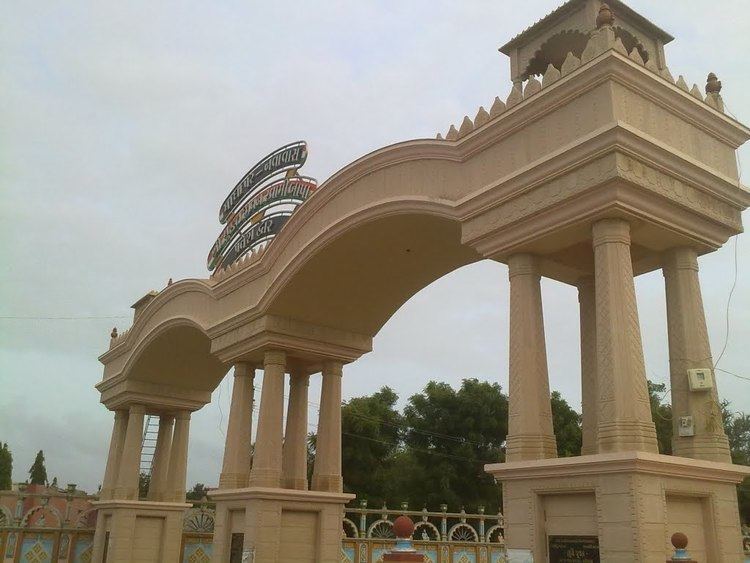PIN 370020 Elevation 105 m Area code 2832 | Time zone IST (UTC+5:30) Telephone code 2832 Area 26.67 km² Local time Friday 7:50 PM | |
 | ||
Weather 29°C, Wind W at 23 km/h, 24% Humidity | ||
Madhapar is a large village located in the south western Kutch district in the state of Gujarat, India. Bhuj is the regional hub of the town where the nearest airport exists. It serves three flights daily to Mumbai.
Contents
- Map of Madhapar Bhuj Gujarat
- Madhapar village women s contribution in 1971 war vtv gujarati
- Present status
- History
- Notable persons
- Schools
- Geology
- Temples
- Economy
- References
Map of Madhapar, Bhuj, Gujarat
Madhapar village women s contribution in 1971 war vtv gujarati
Present status
The town of Madhapar, with a population of more than thirty two thousand people, some 3 km from the main town of Bhuj in the province of Kutch (Gujarat), is wealthiest town in the whole of Southern Asia with an average GDP of $12,0000 per person.
In recent times, the town has become greener, with new lakes, check dams and deep bore artisaaln wells that provide fresh water all year round. It has new health centers, playing fields, parks and temples.
History
Madhapar is one of the 18 villages established by the Mistris of Kutch. In the 12th century, many people of the Mistris community moved into a village named Dhaneti and later settled between Anjar and Bhuj. Madhapar is named after Madha Kanji Solanki who had shifted from the Dhaneti village to Madhapar in the year 1473-1474 (VS 1529). Madha Kanji was the third generation of Hemraj Hardas of Solanki dynasty of Gujarat, who moved from the Halar region to Dhaneti and then to Madhapar. This early Madhapar today is known as Juna Vaas (Old Residence). These warrior Kshatriyas later came to be known by Mistri mainly because of their occupation. These Mistris have founded the Juna Vaas and contributed a lot to the development of all early infrastructure, temples of the village and erection of other architects of Kutch.
The Patel Kanbi community moved into the village around 1576 AD (V.S. 1633). Navo Vaas (New Residence) was started in around 1857, by which time Madhapar had become congested and other communities like the Kanbis had also increased and prospered.
The village was not harshly affected by the 2001 Gujarat earthquake that had caused severe damage in the region. However, some of the century old houses of Mistris in Juna Vaas (Old Residence) with unique architect were damaged in the earthquake of 26 January 2001.
Notable persons
During the years of laying of railway lines by the British, 1850–1930, many of the Mistris moved out to become railway contractors.
Some of them also entered into colliery businesses in Bengal - Bihar, Jharia - Bokaro Coalfields area. Among them three persons of Madhapar, a record in itself, were given the title of "Rai Sahib" from the British:
Other notable are:-
Schools
The first government boys' school was started in 1884. Bhimji Devji Rathod of Mistri Community built and started the first girls' school in Madhapar in 1900. The first high school, Madhapar Vidhyalay Saraswati High School, was founded in 1968.
Geology
There are two huge lakes in Madhapar. One is called Jagasagar and was built by Mistri railway contractor Jagamal Bhima Rathod around the year 1900; it is named after him. The other is called Meghrajji Lake, named after Meghrajji, the last ruler of the Cutch State. Karasan Bhima Rathod also built an artificial lake with steps near the Suralbhit Temple, which today is known as Karasan Bhimjee's Pond.
Temples
Sanatan Thakor Mandir, Mahadev Temple, Barla Temple and Swaminarayan Temple (1949) are in Madhapar. Kuldevi Temples of Momai Mata of Solanki, Rathods are also there.
As per records of the old Thakor Madir, Shiva Mandir and the noted Barla Temple were built by Mistri Mandan Jiwani Chauhan of the Mistri community around 1880-90 from the monies he earned as railway contract works in Sindh
Economy
Agriculture plays a large part in the region's prosperity, and most of the agricultural goods are exported to Mumbai. These primarily consist of corn, mangoes and sugarcane.
Many residents of Madhapar work abroad in the UK, USA, and Canada. But they prefer to save their money in India, which has made Madhapar one of the richest villages in terms of bank deposits worth over 2000 crores. The village has earned a special name in India and is considered a barometer of NRI deposits.
The migrant population of Madhapar living outside India have huge love for their village and have formed community associations. In 1968, Kutch Madhapar Karyalay was formed in London to bind the UK Madhapar community together and maintain their cultural activities and traditions.
